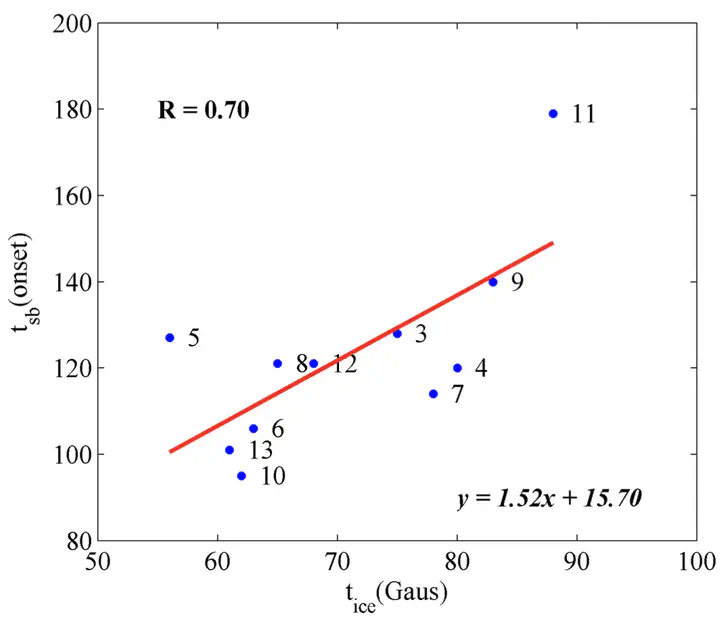The impact of sea ice retreat on the spring phytoplankton bloom over the Labrador Sea Baffin Shelf from 2003 to 2013
 Fig 12. Scatter plot comparing timings for the onset of the spring bloom and sea ice retreat as day number for 2003-2013. Red line is linear regression line. Pearson correlation coefficient R = 0.7 (all years except 2003), significant at 95% confidence interval (based on 10 samples).
Fig 12. Scatter plot comparing timings for the onset of the spring bloom and sea ice retreat as day number for 2003-2013. Red line is linear regression line. Pearson correlation coefficient R = 0.7 (all years except 2003), significant at 95% confidence interval (based on 10 samples).Abstract
I have investigated the climatology of the Baffin Shelf bloom in the Labrador Sea and related its variability to local sea ice dynamics. Motivation for this study stemmed from the critical ecological value spring blooms have on the Labrador Sea ecosystem. The onset of the Baffin bloom typically occurred around late-April, with variation in timing of up 30 days over the 11- year record from Aqua-MODIS satellite ocean chlorophyll, 2003-2013. Sea ice retreat typically occurred from early-March, with similar variations in timing compared to the spring bloom. Sea ice retreat was calculated from Nimbus-7 SMMR and DMSP SSM/I-SSMIS satellite derived sea ice concentration over the same study period. Strong statistical correlations were found between the timing of sea ice retreat (tice) and the onset of the Baffin bloom (tsb) from 2003 to 2013, where an average delay of 52 days existed between tice and tsb each year. In this study, tice was defined as the time when Gaussian fitted annual sea ice concentration was at its maximum, and tsb was defined as the first time chlorophyll exceeded its median +5% threshold, prior to its spring maximum. Specific retreat mechanisms thought to be inducing the bloom were critically assessed based on evidence from existing studies and common sense reasoning. This study suggests the timing of the Baffin bloom is controlled by light limitation due to sea cover. Haline stratification may also be important for bloom intensity and duration. Previous investigations in the Labrador Sea have suggested the spring bloom is divided into two distinct biogeographical zones. Based on the observations here, this study suggests the Labrador Sea is in fact divided into three unique regions, where the Baffin bloom occurs later than central and north blooms. Due to the short, efficient nature of the Labrador Sea food chain, ice retreat induced primary production of the Baffin bloom may have both large and direct consequences for the success of secondary producers, who coincide their reproductive cycles with the spring bloom. Mismatches between primary and secondary producers could prove detrimental to the success of higher trophic levels, particularly under a trend of decreasing ice coverage in the future. Future work could focus on: (1) gaining a greater understanding on the ecological impact of ice-induced spring blooms and (2) identifying more broadly where these blooms may exist, with the aid of northern hemisphere tsb and tice anomalies presented here.